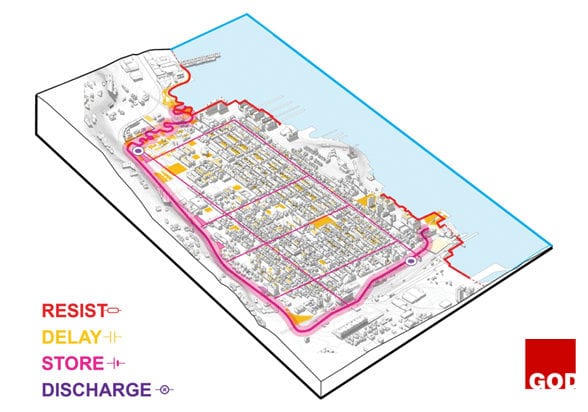You Were Never Made to Be ‘Productive’
Compared to people in other industrialized nations, Americans work longer hours, take fewer vacation days, and retire later in life. Busyness, once seen as the curse of the disadvantaged, has become equated with status and importance. Our work increasingly defines who we are.
“Godly rest (distinct from play, relaxation, or sleep) is inextricably tied to our identity as children of God.”
The solution perhaps is to be “Lazy Intelligent”? That sounds like something an unsuccessful, lazy slacker would say, isn’t it? Actually, it’s the opposite. One of America’s most influential and controversial science fiction authors Robert Heinlein uttered these words during his time. Despite his nod to laziness, Heinlein went on to pen hit titles such as Starship Troopers and Stranger in a Strange Land.
Productive laziness is not about doing absolutely nothing at all. It’s not about just sitting around and drinking coffee or engaging in idle gossip while watching the non-delivered project milestones disappear into the horizon. In fact, this behavior would lead to a very short-lived project management career.
Laziness Is Not Synonymous with Stupidity
Instead, productive laziness should be viewed as a more focused approach to management. Adopting this mindset means concentrating efforts where it really matters, rather than spreading yourself thing over unimportant, non-critical activities that in some cases don’t need to be addressed at all.
According to the Pareto Principle — Also Known as the “80/20 Rule” — 80 Percent of the Consequences Stem from 20 Percent of the Causes.
While the idea has a rule-of-thumb application, it’s also commonly misused. For example, just because one solution fits 80 percent of cases, that doesn’t mean it only requires 20 percent of the resources needed to solve all cases.
The principle, suggested by management thinker Joseph M. Juran, was named after Italian economist Vilfredo Pareto, who observed that 80 percent of property in Italy was owned by 20 percent of the population. As a result, it was assumed that most of the result in any situation was determined by a small number of causes.
Rest Is at the Center of God’s Design
Every smart but lazy person should consider the 80/20 Rule each day. For managers, the principle is a reminder to concentrate on the 20 percent of work that really matters.
Contrary to belief, 80 percent of success is not just showing up. In fact, only 20 percent of what you do during the day will produce 80 percent of your results. Therefore, it is important to identify and focus on that 20 percent during the working day.
When genius and laziness meet, the results can be magical. Being just the right combination of smart and lazy can bring you to have a real edge over others. Interestingly enough, smart lazy people are generally better suited for leadership roles in organizations. These people make great strategic thinkers and leaders. They do things in a smart way in order to expend the least effort. They don’t rush into things, taking that little bit of extra time to think and find the shortest, best path.
They question, contradict, and show dissent against inefficient methods or unnecessary tasks.
“Whenever There Is a Hard Job to Be Done, I Assign It to a Lazy Man; He Is Sure to Find an Easy Way of Doing It. — Bill Gates”
Bill’s not the only guy, who believes that laziness doesn’t necessarily have to be a bad thing. German Generalfeldmarschall Helmuth Karl Bernhard Graf von Moltke was the chief of staff for the Prussian Army for 30 years. He is regarded as one of the greatest strategists of the latter 1800s among historical scholars and is the creator of the more modern method of directing armies in the field.
Moltke observed his troops and categorized them based on their intelligence, diligence and laziness. If soldiers proved to be both lazy and smart, they were promoted to leadership because they knew how to be successful with efficiency. If soldiers were smart and diligent, they were deployed into a staff function, focusing on the details. Soldiers who were not smart and lazy were left alone in hopes they would come up with a great idea someday. Finally, soldiers who were not smart but diligent were removed from ranks.
Like Moltke’s army, the lazy manager is all about applying these principles in the delivery and management of work. You’re likely not stupid since you’ve landed the management position, but how are your lazy skills? Applying smart-lazy tactics will not only allow your work to be more successful, but you will also be seen as a successful individual and a top candidate for future leadership roles.
Think return on investment (time spent versus money earned ratio) rather than busy work and don’t restrict yourself to a certain way of doing things just for the sake of the status quo.
These people make great strategic thinkers and leaders. They do things in a smart way in order to expend the least effort. They don’t rush into things, taking that little bit of extra time to think and find the shortest, best path.
In the wise words of Bill Gate’s and American automotive industrialist Walter Chrysler, “Whenever there is a hard job to be done, assign it to a lazy man or woman for that matter; as he or she is sure to find an easy way of doing it.”
For an overachieving people-pleaser like me, thinking of rest as an innate part of who we were created to be—not as a discipline or something to be earned—is compelling. It is yet another form of God’s infinite grace, one that’s needed today more than ever.
Co-Author Peter Taylor
Described as “perhaps the most entertaining and inspiring speaker in the project management world today”, Peter Taylor is the author of two best-selling books on ‘Productive Laziness’ – ‘The Lazy Winner’ and ‘The Lazy Project Manager’.
Fighting Gender Discrimination in The High-Tech World
New research suggests that tech-savvy women might face gender discrimination in jobs at high-tech firms, partly due to mismanaged projects.
It shows gender discrimination is still as prevalent in the UK as it was 20 years ago, and comes as International Women’s Day will be celebrated this week on March 8, for the 103rd year.
The book “The Recruitment, Retention and Advancement of Technical Women: Breaking Barriers to Cultural Change in Corporations” by the Anita Borg Institute for Women and Technology, a Palo Alto-based nonprofit organization focusing on the role of women at high-tech firms.
“More than a Quarter of Women Have Experienced Some Form of Gender Discrimination in the Workplace, a New Study Shows.”
Tech firms typically rely on a “hero mindset” to save poorly organised runaway coding projects. As a result, employees with family responsibilities (generally considered to be women) are left out, the report said.
The Research Also Suggests out of 1,500 Office Workers in the Uk, 26% of Women Felt That Having Children Held Them Back in Their Career
The research also suggests that there is evidence of bias against women in recruitment and job assignment in places where high-tech corporate cultures thrive on this “hero mindset” that “rewards a ‘last minute’ crunch where 24/7 work becomes necessary to ‘save’ a project.” However, these environments fail to acknowledge family responsibilities and flexibility needs, the report said.
This fly-by-the-seat-of-your-pants workday culture represents a pattern that’s grown mainly because an organization poorly defines project management and requirements.
For example, Silicon Valley’s sometimes frantic fire-fighting pace and in-your-face communication style produces many technical cultures that often “leave women feeling isolated and crushed,” notes the report.
The study also reflects what 59 senior business and tech managers — both men and women from companies like Cisco, Facebook, Goldman Sachs, Google, HP, IBM, Intel, Microsoft and Symantec — shared during a closed forum organized by the Anita Borg Institute. According to the report, it’s common in the high-tech world to find the modern equivalent of the “good old boys network” that tends to hire “people who are like them.”
Technical women these days are “still a rarity,” said Dr. Carolyn Simard, author of the report. She added that in the United States, women earn just 18 percent of computer science degrees in college. That figure is sharply down from the 37 percent observed in 1985. Yet technical demand is still expected to grow as much as 32 percent by 2018.
The Institute published a second report titled “Senior Technical Women: A Profile of Success,” which surveyed approximately 1,800 participants from seven unidentified high-tech firms in Silicon Valley.
It found that women now hold about four percent of the senior-level technical positions at high-tech firms and an estimated one-quarter of all tech jobs. On higher levels, women are more likely to end up in a managerial position compared to men (36.9 percent of women compared to 19 percent of men), who are more likely to hold “individual contributor positions” in technical coding jobs.
The second study also found that men and women in technical jobs value most of the same attributes for success, such as being analytical, questioning, risk-taking, collaborative, entrepreneurial, assertive, working long hours and being sociable.
Far more often than men, women generally have “primary responsibility for the household,” the study showed. However, senior-level tech women are much more likely to have a partner who holds primary responsibility for the household and children (23.5 percent of partnered senior women) compared to entry or mid-level women (13.4 percent). Senior-level tech women are also more likely than their male counterparts to forego a partner and children because they believe they might hinder their careers.
To improve work-life balance and stop any perceived gender bias against women in the high-tech world, the Anita Borg Institute is pushing a few ideas that will generate debate and controversy.
“The Equality Act 2010 Makes It Unlawful for an Employer to Discriminate Against Employees Because of Their Gender.”
One recommendation suggests that because there is evidence that women are eliminated in the hiring process at the resume review level, companies might consider “that all women candidates should at least get an interview.”
With backing from firms like HP, Google, Facebook, Intel and Intuit, the Anita Borg Institute even suggested that it might be possible to create a software tool designed to weed out any unconscious bias against hiring or promoting women in the tech world.
This “software tool for detecting bias” was proposed at the Institute’s forum. It can use language recognition to zero in on everything from performance evaluations to letters of recommendation that exhibit gender bias. An online tool like this can be found at Harvard’s Project Implicit.
“We envision building on such research to create a system where specific language can be fed and analyzed for the existence of bias,” the report said. “Using machine learning and text analysis methods would help organizations and individuals address the existence of bias before the damaging language is formally used in recommendations or evaluations.”
Additionally, the software would be a “high-impact diagnostic tool for calibrating organizations with regard to hiring and promotion decisions.”
Bhargava the Founder of 5-hour Energy Wants to Put People Power to Good Use
35 Powerful Quotes That Will Inspire You to Be Successful
Being a both a Christian and a leader can be an emotional ride, with ups, downs, joy, and disappointment. Words have power and these inspiring and motivating quotes are guaranteed to challenge the way you think and perhaps even change the way you live.
We hope they resonate with you as much as they have with us. Sometimes a little piece of advice or wisdom from a brilliant mind can help you motor through even the most difficult of times.
- I’ve learned that people will forget what you said, people will forget what you did, but people will never forget how you made them feel. ’- Maya Angelou
- It’s not the load that breaks you down, it’s the way you carry it. ’- Lou Holtz
- What happened, happened, and it wouldn’t have happened any other way. Lewis Carroll
- Choose a job that you like, and you will never have to work a day in your life. ’- Confucius
- Fools give full vent to their rage, but the wise bring calm in the end. ’- Proverbs 29:11
- Perfection is not attainable, but if we chase perfection we can catch excellence. —Vince Lombardi
- Whatever the mind can conceive and believe, the mind can achieve. ’- Napoleon Hill
- Keep away from people who try to belittle your ambitions. Small people always do that, but the really great make you feel that you, too, can become great. ’- Mark Twain
- The function of leadership is to produce more leaders, not more followers. ’- Ralph Nader
- As iron sharpens iron, so one person sharpens another. ’- Proverbs 27:17
- If you cannot do great things, do small things in a great way. ’- Napoleon Hill
- What is not started will never get finished. ’- Johann Wolfgang von Goethe
- When you cease to dream, you cease to live. ’- Malcolm Forbes
- Build your own dreams, or someone else will hire you to build theirs. ’- Farrah Gray
- Your most unhappy customers are your greatest source of learning. ’- Unknown
- Winners never quit, and quitters never win. ’- Vince Lombardi
- Your time is limited, so don’t waste it living someone else’s life. ’- Unknown
- Life is 10% what happens to me and 90% of how I react to it. —Charles Swindoll
- The price of success is hard work, dedication to the job at hand and the determination that whether we win or lose, we have applied the best of ourselves to the task at hand. ’- Vince Lombardi
- Speak your mind, even if your voice shakes. ’- Maggie Kuhn
- It takes 20 years to build a reputation and five minutes to ruin it. If you think about that, you’ll do things differently. ’- Warren Buffett
- Remember no one can make you feel inferior without your consent. —Eleanor Roosevelt
- When someone tells me “no,” it doesn’t mean I can’t do it, it simply means I can’t do it with them. ’- Karen E. Quinones Miller
- If you want to lift yourself up, lift up someone else. —Booker T. Washington
- You can’t build a reputation on what you are going to do. ’- Henry Ford
- A person who never made a mistake never tried anything new. ’- Unknown
- I am not a product of my circumstances. I am a product of my decisions. —Stephen Covey
- Logic will get you from A to B. Imagination will take you everywhere. ’- Unknown
- Remember that not getting what you want is sometimes a wonderful stroke of luck. ’- Unknown
- I can’t change the direction of the wind, but I can adjust my sails to always reach my destination. —Jimmy Dean
- If you’re offered a seat on a rocket ship, don’t ask what seat! Just get on. —Sheryl Sandberg. — Proverbs 15:1
- A gentle answer turns away wrath, but a harsh word stirs up anger
- Everything you’ve ever wanted is on the other side of fear. —George Addair
- The most difficult thing is the decision to act, the rest is merely tenacity. —Amelia Earhart
- A good name is more desirable than great riches; to be esteemed is better than silver or gold. — Proverbs 22:1
Bookmark this page and come back to it when you need some inspiration and motivation.
66% of IT Projects Fail
Only one in three software projects will turn out to be successful. According to Standish Group’s 2015 Chaos report, 66% of technology projects (based on the analysis of 50,000 projects worldwide) end in partial or total failure. More surprisingly, these statistics have been the same for the last five years, the report shows. Furthermore, 17% of large IT projects go so badly that they can threaten the very existence of a company.
On Average, Large It Projects Run 45% over Budget and 7% over Time, While Delivering 56% Less Value than Predicted
Despite such failures, huge sums continue to be invested in IT projects and written off. For example the cost of project failure across the European Union was ┚¬142 billion in 2004.
It Projects Always Come with an Element of Risk, but There Are Huge Gains to Be Had If We Can Just Avoid Some of the Factors That Contribute Frequently to Project Failure
What makes a IT project successful, though?
According to the Standish Group, a successful project is on time, on budget and has satisfactory results (value, user and sponsor satisfaction, and meets target requirements). Other measures of success are widely known and accepted as true such as getting requirements right, providing effective leadership, and having full support and engagement from sponsors and users. Without these, it’s unlikely that any project would succeed.
But there’s more to success than what is widely known and, apparently, rarely followed. To reduce the risk of failure for your tech project, here are six key actions to take on the road to success.
1. Executive Vision and Involvement
Without a Executive Senior Sponsor Its Easy for Projects to Fail with the Organizational Resistance That Accompanies Large Change
Executive involvement is a primary variable in predicting the success of an IT project. Having a leadership team aligned across an organization articulating the purpose, value, and rationale for a project goes a long way towards getting stakeholders and end-users pulling the proverbial rope in the same direction.
2. Have a clear view of scope and timetable
Oftentimes, a tech project flops because its developers fail to plan and rush forward with an idea. However, some project managers plan so meticulously that they end up falling behind and lose momentum. The best approach is somewhere in between.
Interviewing team members, documenting requirements, prioritizing what is “mission critical” versus “nice to have,” getting agreement across stakeholders can feel like a never-ending cycle. As a result, requirement gathering has fallen out of fashion with many organizations in the past few years.
However, the ideal starting point for a successful technology project is to have a set of fundamental requirements with sufficient detail to develop against.
Requirement Gathering Is Labour-intensive and Challenging but Remains the Roadmap and Measuring Stick for Software Projects
This approach allows you to maintain sight of the business benefits as well as engaging stakeholders and responding to their feedback. In combination with a clear business case, a well-defined set of requirements also simplifies design and testing, two areas where projects tend to go sideways.
Ensure that requirements for the project are clearly defined and agreed upon among stakeholders and that you have a way to track, measure, and manage changes in requirements as appropriate during the project.
3. Define how you will deliver
When it comes to delivering a major project, one size does not always fit all. All products are customizable to some degree, so what might have worked in one company may not work in another company.
That being said, why reinvent the wheel if it’s already proven successful? Sometimes it can be more beneficial to use an existing off the shelf solution. Whichever direction you take, choose the delivery mode that works best for your company.
4. Risk Identification and Management
Every project has risk and there are many factors out of your control. People leave the organization, for better or worse, leadership changes, budgets get cut, however, many risks to projects can be mitigated or even eliminated with some forethought and on-going management. For example, do you have the resources you need to deliver the project (resource risk). Are project goals clearly understood and requirements clearly defined (scope risk). Do you have a realistic project plan and timeline (time risk).
Mitigating Risk Is a Combination of Science and Art, and Always a Balancing Process
5. Test your product again and again
A technology project is something that should overall support your business. It should not be something that dictates and forces you to change your operations. If this is happening, you should shift gears and focus on tweaking the technology, rather than lowering expectations and adopting less ideal requirements.
Adequate testing is a must for any tech project. While some features may be fine with automated testing, the best approach is to have a dedicated testing team. Testing activities should mirror those with the development team throughout the project’s lifetime. With thorough testing, a project should deliver with less design flaws or missing requirements.
6. Prioritize simplicity and performance
Developers often leave the external look and feel of a product to the wayside thinking these things are not necessities for the consumer to enjoy. However, user experience is absolutely critical to the success of the project.
Developers must consider things like storage, network requirements, processing speeds and overall performance in order to satisfy the customer. If users are going to have to wait for an extended period to allow information to load, there must be a good reason for the wait, otherwise they won’t return for future products.
Simplification and Improved Efficiency Is What Adds Value
Ultimately, using the product should be a smooth and intuitive experience. Additionally, tools and alternative routes must be placed logically without being intrusive. The process can be complicated, but the finished product should emit simplicity. After all, that’s what makes companies like Apple so successful. Simplification and improved efficiency is what adds value.
A Day in the Life of a Project Manager
We all know that project managers are responsible for managing projects through to completion while remaining on time and within budget, but how exactly do they do it? What does a typical day look like for a project manager?
Here’s a sample of what a typical day might look like for a project manager.
The Early Bird Gets the Worm, Success Comes to Those Who Prepare Well and Put in Effort
8.30 am: Starting the day
After settling in for the day’s activities, it’s time to plan out the day. Start up the computer, email clients, draft team schedules, organize time sheets and create the to-do list.
To-do lists help managers and their teams stay on track. If a manager notices that one team member has yet to deliver an assignment, they can address this issue first thing in the morning; otherwise, delays can build up and affect the project. Likewise, lists help managers see the next course of action for projects.
9:15 am: Time to get moving
Efficiency is a must and there is no time to be wasted in project management. After a quick review of project plans and to-do lists, the manager must be prepared to get his team moving right away.
Round up team members, review the project’s current position and emphasize the next course of action. In order to get the team moving on assignments, strong project managers set deadlines throughout the day.
Morning team meetings are also necessary to make sure each member understands the project and their assignments. It’s also a time to answer any questions for clarity or to get feedback or concerns from individuals.
While daily group meetings can be important, they are not always necessary and can be counter-productive. If the team is on the same page and everyone is ready to tackle the tasks of the day, spend a short period re-grouping so that the team can get on and complete their assignments. There’s no need to spend hours planning and reviewing.
10 am: Meetings, meetings, meetings
More than one project manager will be more than likely in the office and they will all need to work together for the benefit of the programme. This is why meetings with other managers and higher ups are necessary in a project manager’s day.
Meetings allow each project manager to go through the status of their respective projects and to track the weekly schedule and other deadlines. It is also a time to address any business-critical tasks that might come up.
It’s worth considering that only 7% of communication is spoken. The other 93% is made up of tone (38%) and body language (55%). So although facts and figures are easily communicated via email, letter or phone, an actual discussion or negotiation is best handled where you can see the other person and therefore are able to see for yourself what their tone and body have to say on the matter.
10:30 am: Tackling the small stuff
Meetings will be on and off throughout the day for project managers, which is why it’s important to tackle the small tasks in between appointments. Small tasks include wrapping project reports, booking future meetings, answering correspondences with other colleagues, reviewing items and team reports among other things.
It’s also important to schedule post-mortem meetings with the project team to review the success of projects in order to apply any lessons learnt to future projects.
11 am: Project kick-off meeting
When one project ends, another begins, which means it’s time for yet another project kick-off meeting. Kick-off meetings can take on various forms, depending on the type of business. However, they all share the same basic needs.
Every individual involved with the new project should be in attendance and have the latest version of project specifications in written form. As project manager, it might be wise to send this to team members several days before the kick-off meeting to ensure everyone has time to review.
During a kick-off meeting, it’s important to review the overall goals for the project, both commercial and technical details, break down functional requirements, and spend time for discussion and questions. By allowing team members to communicate questions and share ideas, it opens the lines of communication and may bring up potential concerns that might have been missed in the initial planning stages.
Conclude kick-off meetings with a definition of the next steps and be sure individuals are aware of deadlines and their assignments.
11:30 am: Reviewing project specs, budgets and scheduling submissions
Other important tasks to tackle in between meetings include reviewing specifications and budgets and schedules for future projects. If a project begins that day, now would be a good time to apply the finishing touches to the project documentation before presentation and approval.
When it comes to establishing project estimates and budgets, a project manager must bring all of his experience into play in order to create a realistic budget that includes wiggle room for factors such as project complexity, team experience and skill levels, stakeholders involvement, time needed, third-party services needed, and contingency allowances among many other things.
It’s Not Easy to Squeeze in a Lunch Break, but It’s Often Necessary for the Project Managers Health and Sanity
12 pm: Lunch
In the midst of the seeming chaos that is project management, be sure to fuel up for the rest of the day’s work. Lunch is also a great span of time to check in with team members to make sure they are still on target for later-day deadlines.
2 pm: Launching the next project
After digesting lunch, it’s time to launch the next project. Get the whole team ready to go live and present the project to the client and begin testing aspects of the project in a live environment. It’s a time to spot problems and address them and review schedules and deadlines and other project needs.
3 pm: Time for everything else
The final two hours in the office are spent addressing everything else on the project manager’s plate. A project manager must be good at multi-tasking and whatever duties couldn’t be accomplished throughout the day are reserved for the final hours. Most of the time, lower priority tasks are reserved for afternoon hours. These tasks could include project update meetings with various departments, logging finances, reviewing monthly project schedules, approving time sheets, writing weekly reports, sorting purchase orders and communicating with suppliers. There are so many other small to-do list items that project managers are responsible for, but are often overlooked.
Spending Time at the End of the Day as Well as the Beginning to Review and Plan Will Only Help You Succeed as a Project Manager
5 pm: Review the day, plan for tomorrow
Before heading home, review the day’s list and what’s been accomplished. Anything that has been added or was left unfinished should be scheduled for the next day or sometime throughout the week. Reflect on your team’s work and clear the email inbox. Use a filing system that makes sense for you and be ruthless about deleting stuff. The beauty of an empty inbox is a thing to behold. It is calming, peaceful and wonderful.
‘Creation From Catastrophe’ a New exhibition looks at how architects are doing more to prepare us for disaster – but is it enough?
Out of the ashes rises great opportunity. That is the theme of the new exhibit “Creation from Catastrophe — How Architecture Rebuilds Communities” at the Royal Institute of British Architects. Featuring a number of impressive projects dedicated to rebuilding communities after a disaster, the exhibit explores the evolving relationship between man, architecture, and nature.
In an interview with Dezeen magazine, curator Jes Fernie said the exhibit reveals an “expanded idea of what architecture is and what architects can do.”
From Floating Schools to Unseen Plans for an Alternative London, a New Exhibition Showcases the Good, the Bad and the Ugly Architectural Responses to Urban Disasters
The exhibit, which opened on Jan 27 and runs through April 24, spans nearly four centuries riddled with successful disaster relief projects. It features designs for rebuilding after London’s Great Fire in 1666 as well as plans for water communities in Nigeria, which could be affected by unpredictable coastal water levels in Africa’s near future.
Here are five other unique projects you can follow up on when visiting the Catastrophe exhibit this spring:

1. The Reliance Building, Atwood, Burnham and Co., North State Street, Chicago, 1890-1895
While devastating, Chicago’s Great Fire of 1871 paved a new way for architectural design. Considered by many to have birthed the Chicago School architectural style, the disaster also led to a new type of architectural design: the skyscraper.
In an effort to create fire-retardant buildings, designers utilized tools such as steel frames and sheet glass coverings. The Reliance Building, constructed by Atwood, Burnham, and Co, is one of the first post-fire buildings that fathered a design very similar to the modern day skyscrapers we know.


2. Housing for Nepal earthquake victims, Shigeru Ban, 2015
Simple, traditional homes in Nepal were the ones that withstood the catastrophic earthquake in 2015. As a result, Pritzker Prize-winning, disaster-relief architect Shigeru Ban designed housing structures for the victims.
Ban’s modular housing concept is modelled on the traditional homes that survived the earthquake. His design uses wood frames for the structure, cardboard tubes for the truss system of the roof, and debris from the disaster as infill for the wall. Thatch and plastic sheeting provided an extra layer of protection on the rooftop.

3. Women’s Centre in Darya Khan, Pakistan, Yasmeen Lari, 2011
Pakistani architect Yasmeen Lari (the first woman architect in Pakistan) showcases architecture’s role and influence in society. Throughout her career, the 75-year-old designer has built over 36,000 homes for earthquake and flood victims throughout Pakistan. She is also the founder of Heritage Foundation of Pakistan, which allows architecture students to train local residents to rebuild their homes and communities after a disaster using natural resources like bamboo and mud.
One of her well-known projects includes the Women’s Centre in Darya Khan, Pakistan. Lari holds a deep affection for Pakistani women, who are typically displaced and struggling with the care of their children following a natural disaster. The layout allows women to unite and socialize and keep their children safe. And in the event of a flood striking, the first floor is high enough so that waters cannot reach it.

4. Post-tsunami sustainability plan for Constitución, Chile, Elemental, 2014
After 2010’s deadly earthquake shook the coastal cities of Chile, plans for rebuilding and protecting cities like Constitución became a priority. In an effort to work with nature and the community, Pritzker Prize-winning architect Alejandro Aravena’s firm Elemental, proposed the intriguing method to plant more trees along the coast to absorb waters and prevent flooding.
The idea is that there is an opportunity to do something that would have long-term positive impacts, rather than a temporary fix that might be ruined by another major earthquake or tsunami in the area. The project will hopefully address short-term needs as well as potential long-term problems.

Resist. Delay. Store. Discharge. A Comprehensive Urban Water Strategy

5. Rebuilding of Hoboken, New Jersey after Hurricane Sandy, OMA, 2012
Following the disastrous Hurricane Sandy that struck the Northeastern United States in 2012, about 80 percent of Hoboken, New Jersey homes were flooded, leaving the community wondering how to rebuild itself with an emphasis on flood defense.
That’s when Dutch architect Rem Koolhaas’ firm OMA offered a solution that would combine hard infrastructure and soft landscaping, integrating coastal defense and natural drainage to protect against future flooding. The ideas between OMA’s and Elemental’s projects are very similar in that they look to work with nature rather than avoiding it.
Fernie told Dezeen that OMA offers a multi-pronged approach: resist, delay, restore and discharge. It acknowledges the complex water system and works with it, he said.
How To Deliver On The Promise of MegaProjects
Due to the large scale and outlook attached to them, mega-projects have a large opportunity for failure. Typically, the failure begins at the outset of the project, whether that be due to poor justification for the project, misalignment among stakeholders, insufficient planning, or inability to find and use appropriate capabilities.
Underestimated costs and overestimated benefits often offset the baseline for assessing overall project performance. This is why it is important for organizations to first establish social and economic priorities before even considering what projects will answer their needs. Once social and economic priorities are established, only then can a project be considered. Selecting projects must be fact-based and transparent in order to ensure accountability with stakeholders and the public.
Successful Megaprojects Must Have Robust Risk-analysis or Risk-management Protocols
It’s also important to maintain adequate controls. Successful megaprojects must have robust risk-analysis or risk-management protocols and provide timely reports on progress relative to budgets and deadlines. Typically, progress is measured on the basis of cash flow, which is less than ideal as data could be out of date and payments to contractors do not correlate construction progress. Instead, project managers should deliver real-time data to measure activity in the field. For example, cubic meters of concrete poured relative to work plans and budgets.
Overall, improving project performance requires better planning and preparation in three areas: doing engineering and risk analysis before construction, streamlining permitting and land acquisition, and building a project team with the appropriate mix of abilities.
Project developers and sponsors should put more focus into pre-planning such as engineering and risk analysis before the construction phase. Unfortunately, most organizations and sponsors are reluctant to spend a significant amount of money on early-stage planning because they often lack the necessary funds, they are eager to break ground and they worry the design will be modified after construction is underway, making up-front designs pointless.
However, it’s proven that if developers spend three to five percent of capital cost on early-stage engineering and design, results are far better in terms of delivering the project on-time and on-budget. This is because through the design process, challenges will be addressed and resolved before they occur during the construction phase, saving both time and money.
It’s not unusual for permits and approvals to take longer than the building of a megaproject. However, if developers look to streamline permitting and land acquisition, that would significantly improve project performance. Best practices in issuing permits involve prioritizing projects, defining clear roles and responsibilities and establishing deadlines.
In England and Wales, developers applied these approaches to cut the time needed to approve power-industry infrastructure from 12 months to only nine months. On average, timelines for approval spanned four years throughout the rest of Europe. Likewise, the state of Virginia’s plan to widen Interstate 495 in 2012 was able to cut costs and save hundreds of homes thanks to land acquisition planning by a private design company.
Investors and Owners Must Take an Active Role in Creating the Project Team
When it’s all said and done, projects cannot deliver the best possible return on investment without a well-resourced and qualified network of project managers, advisers and controllers. Investors and owners must take an active role in creating the project team.
It’s not enough to have a vague overview of what the project might look like in the end. Instead, it’s necessary to review risks and costs and draft a detailed, practical approach to tackle various issues. An experienced project manager cannot do it all alone. The project team must include individuals with the appropriate skills, such as legal and technical expertise, contract management, project reporting, stakeholder management, and government and community relations among others.
Failure to Properly Plan for These Projects Could Have a Negative Impact on Society
While mega-projects are important in filling economic and social needs, failure to properly plan for these projects could have a negative impact on society. Take Centro Financiero Confinanzas (Venezuela), the eighth tallest building in Latin America at 45 stories, located in the financial district of Venezuela’s capital, Caracas for example.
To those unaware of its history, the Centro Financiero Confinanzas is actually home to over 700 families, a “vertical slum” that is a truly fascinating example of reappropriation of space in an urban environment. An ironic symbol of financial failure that was intended to represent the unstoppable march of Venezuela’s booming economy.
It’s much more than an unbuilt building, bridge or tunnel, failed mega-projects are a blow to the economic growth and social improvements of communities around the world.
Why Should I Hire a Project Manager for My Church Project?
Is it worth hiring a project manager when any seemingly knowledgeable pastor or church member might do?
The truth is, project managers can be a valuable asset to any organization. Whereas the average church member who is only familiar with certain tasks might be overwhelmed by the complexity of major organizational assignments, project managers are trained to handle programs with elaborate factors such as high budgets, increased manpower and layers of duties.
An Astounding 97% of Organizations Believe Project Management Is Critical to Business Performance and Organizational Success. (Source: PricewaterhouseCoopers)
On the flip side, some professional bodies disagree, arguing that professionals like pastors, marketers, and accountants are able to manage projects just as well as any project manager with some effort.
Barely over Half (56%) of Project Managers Are Certified (Source: Wrike)
“It’s a raging debate,” said Tony Marks, author of the 20:20 Project Management guide.
“Some industries, such as oil and gas, are hesitant to hire outside project management specialists because they may lack industry knowledge. Instead, these industries prefer to employ technical experts and put them through project management training.”
“The danger is that these people are more likely to get sucked into their comfort zone dealing with the nitty-gritty and technical detail they understand and are fascinated by when they should be managing the project,” said Tony Marks.
In addition to being trained to juggle tasks efficiently, project managers spend an enormous amount of time honing their skills. Much more goes into the craft than obtaining Prince2 or APM certifications.
According to Mike Savage of Thales Training and Consultancy, the International Project Management Association requires its professionals to have at least 15 years of experience and training. The association has four grades from D to A. At the A level, project managers must have a minimum of five years project management experience, five years of program management and five years of portfolio management.
“So to Say That Anyone Can Be a Project Manager Is like Saying Anyone Can Be a Brain Surgeon, Said Savage.”
But just because there are individuals specializing in project management doesn’t mean non-specialists can’t learn the techniques as well. Ian Clarkson of training course provider QA encourages everyone to learn project management practices.
“The skills, leadership, planning and stakeholder engagement techniques are vital to all disciplines,” he said.
“Projects which are run by engineers with project management training are less likely to be successful than the reverse,” said Lloyd’s Register energy program director Roger Clutton. “If there is a lack of technical expertise that will show up in the risk assessment. But a lack of project management skills is much less likely to be detected.”
With that, it seems that the argument on whether or not hiring an outside project management is necessary will continue. But the debate only seems relevant to rival professions as there is projected to be 15 million new project management jobs within the decade. (Source: Project Management Institute).
No matter how you look at it, though, it seems that trained and experienced project managers must be worth their weight in gold.
The Good, the Bad and the Ugly of Project Management for Christian Leaders
It’s Monday afternoon at the office. The week has only begun, but you’re already swimming in a sea of memos, spreadsheets, and schedules. Just as you’re daydreaming about what leftovers you might reheat for a late dinner, your boss pokes his head into your office. He or she mutters something about quotas and deadlines before he or she drops the bomb about a “little project” he or she needs you to complete by the end of the week. And just like that, you know you’ve been handed a nightmare but for whatever reason accept the challenge.
“According to the Cranfield School of Management in the Uk, 68% of Projects Are Destined for Failure Before They Even Start.”
The lack of project management training or experience of many Christian leaders can be an enormous stress factor for them. Whilst natural organizational ability is enormously helpful, in itself it is no guarantee of any project being both successful and low stress.
What is a nightmare project? It’s something we’re all familiar with. The boss assigns us some vague task and a deadline but leaves the means to a solution up to our creative intellect.
So how do you solve the problem of this dreaded “project”?
1. Understand the scope of the project
First things first, create a list to layout your ideas on how to go about the job at hand. Write out questions you might have that need to be answered, people you might need to work with or talk to in order to understand what work must be done.
Without fully understanding what work must be done, it is impossible to accurately estimate a project’s schedule or budget.
After creating a list, share your ideas with colleagues. Work with peers who have the same goal and share the same work ethics as you. Too often, when faced with an unrealistic project, we tend to work with just about anybody who wearily agrees to have their name on board. The enthusiasm of a new project quickly fades when actual work is needed. Instead of “How can I help?” were met with “I’m busy right now” and “Can it wait until next week?” The sponsor, project manager, and project team must share a common understanding of the scope of the project.
2. Get estimates from the people who will be doing the work
To avoid the stress of friendly fatigue, create a solid plan of action with your co-workers. Assign duties and responsibilities and set a deadline for each task.
4. Re-estimate as soon as you realize an estimating assumption was wrong
Don’t get discouraged if people and other things fall through. Even though it’s frustrating with the broken promises, missed deadlines, mistakes, and poor quality outputs. As soon as you realize a mistake was made, assess the impact and re-estimate the project.
“Unfortunately When Project Managers Spend the Majority of Their Time Trying to Achieve the Unachievable, the Result Is Frustration and Potential Burnout.”
But say you’ve followed those steps and were able to remain positive throughout this grueling week. You completed the assignment, whether enthusiastically or completely drained of all energy, only to be told the higher-ups decided to go a different route and don’t need the results of your project after all. “Good effort, though,” your boss tells you as he or she hands back your laminated report.
If you find yourself in this situation, just remember to never say “yes” to a “little project without first taking a look at what you’ve been handed.
Top 6 Most Impressive Megaprojects of 2015
Megaprojects are crucial to the future of most cities, states, and individual livelihoods, however, they also attract a lot of public attention because of the substantial impacts they have on communities, environments, and government budgets. The objective of these projects is to unlock higher growth paths for the economy, as such, they require care in the project development process to reduce any possible optimism bias and strategic misrepresentation.
The problem is that these projects often go off the rails, either with regard to budget, time or both.
The risks associated with MegaProjects, those costing 1 billion or more, are well documented. In one influential study, Bent Flyvbjerg, an expert in project management at Oxford’s business school, estimated that nine out of ten go over budget.
The first factor is that the size of a MegaProject can be so large and unique that it is difficult to model the costs and logistics. Another factor is that MegaProjects are backed by governments which are not typically known for their success in budgeting or efficiency.
In today’s post, we’ve identified the Top 6 most impressive MegaProjects of 2015. These MegaProjects will transcend time and continue to bestow wonder upon new generations.
1. Mall of the World, Dubai

Dubai has a very ambitious project on its hands. Dubai’s Mall of the World will have its very own Oxford Street and Broadway. It will also have galleons and waterfalls. However, the most challenging part of this project is that the area will be covered by a giant retractable roof during the summer months and be climate-controlled creating the world’s first temperature controlled city.
Dubai Mall of the World Set to Put Uae Retail ’20 Years Ahead’ of Gulf Region
Launched with a fanfare by the emirate’s ruler, Sheikh Mohammed bin Rashid al Maktoum, it is the first state-sponsored mega-project to emerge from Dubai since the pre-crash bubble. After years of stalled projects the big plans are back and they are more ambitious than ever before.
It is thought the huge construction will attract 180 million visitors a year and developers hope it will secure Dubai’s futures as a tourism hub.
The Mall of America (MoA) is a gigantic shopping mall owned by the Triple Five Group and is by far the largest mall in the United States. However, the $325 million expansion of the nation’s largest shopping center is now underway. The project consists of a luxury 342-room hotel, an office tower and more than 50 shops and restaurants. Some 1,000 jobs are expected to be created during the construction phase of the project, and 2,500 permanent jobs from retail, hotel and office operations.
The Triple Five Group, owned by Canada’s Ghermezian family, owns and manages the Mall of America, as well as the West Edmonton Mall. MoA is located in Bloomington, Minnesota (a suburb of the Twin Cities).
3. Zurich North America, Chicago, IL


The $333 million site is currently under construction and will be the largest build-to-suit office project in Chicago. Zurich a north america insurance company headquarters includes a 735,000 square foot building rising to 11 stories at its tallest, shaped something like the letter A resting on its side.
Zurich looked at a multitude of factors and in the end made the decision that investing in a new state of the art regional headquarters would be the right choice. The project is due to be completed late summer of 2016.
4. Dubai World Central Airport


This massive $32 billion structure sent its first commercial jet into the air in late October 2013. The project isn’t scheduled for full completion until 2027 and is expected to become the world’s busiest airport, however, with plenty of other contenders quickly taking shape in Asia and the Middle East, it’s has stiff competition.
Dubai World Central Airport is expected to shuttle 160 million passengers through Dubai every year making it the busiest airport on earth.
5. Bao’an International Terminal 3

Bao’an plays a pivotal role in the Pearl River Delta: It serves both Shenzhen and Hong Kong, via a connecting ferry. Terminal 3 is an expansion project designed by the Italian architect Massimiliano Fuksas. The centrepiece of the expansion is a new runway, which is built on a 108,000-foot piece of land reclaimed from the River Delta.
6. Crossrail

Crossrail tunnelling began in 2012 and ended at Farringdon, London in May with the break through of tunnelling machine Victoria. Eight 1,000 tonne tunnelling machines bored 26 miles or 42 km of new 6.2m diameter rail tunnels under London.
London is the fastest growing capital city in Europe and today it is home to 8.6 million people with the population expected to reach 10 million by 2030. TfL’s work is critical to supporting the continued growth and regeneration of London.
As we reflect upon these impressive feats by mankind, we can only imagine what the next big wonder will be. Is it the secretive Nicaragua canal? Could it be Elon Musk’s proposed Hyperloop concept? Or perhaps it will be a new state of the art high speed train developed by China, USA or the UK?
Did we miss one? Please let us know by commenting below.
Yes, You Are Called to Be a Leader for Christ
Times are changing, and so are the ways people work and collaborate. The idea of being a leader can be daunting.
When you consider the word “leader who and what comes to mind, perhaps your Pastor? The BBC show the Apprentice? Your manager? A colleague at work in another team perhaps or an individual who literally has “Project Leader” on a business card or email signature?
Well, it may not be part of your job title, and you may even struggle to find the words in your job description, nevertheless, the call to follow Christ is a call to leadership.
In the Oxford ditionary a project Is defined as “an individual or collaborative enterprise that is carefully planned to achieve a particular aim”
When you think “project”, you typically think about big things, such as:
- Church building developments
- Developing a new product
- IT system integration
- Writing a tender
But actually, many smaller activities can also be classed as a project, such as:
- Creating and delivering an internal training course at church
- Creating and sending a church e-newsletter
- Creating new team processes
In fact, according to David Allen, pioneer of the productivity system Getting Things Done (GTD), a ‘project’ is any multi-step action. In other words, creating
t may seem glaringly obvious, but someone needs to own a project, and not every church organisation or team has a certified project leader to call upon.
2. Create an action plan
“Make a List of the Actions It Will Take to Get You to the End Goal”
It’s very easy to jump straight in and get moving on a project. Spending time planning can seem like wasted time, but in fact, without good planning, you could be wasting your time and energy on things that just aren’t needed. In other words, skipping the planning phase of a project is a sure-fire way of encountering problems down the line. The basics of what you’ll need to establish include your project vision (or guiding light), what your project will deliver, the risks to the project as well as your budget, resources, and timescales Prayer is the portal that brings the power of heaven down to earth. It is kryptonite to the Enemy and to all his ploys against you. Pray in the Spirit at all times and at every stage of the project.
3. Set a realistic deadline
Without a Deadline Your Project Will Sit at the Bottom of Your To-do List and Will Go Nowhere
When it comes to assessing your timescales, you need to figure out what is realistically achievable, while not padding out your timelines too much.
4. Communicate regularly
Developing a Project in a Bubble Will Result in Problems Later On
Regular communication is vital. Meetings, emails and even a quick trip to your colleague’s desk are all needed to make sure you have not missed anything important and that everyone in on the same page.
5. Faith is not a spectator sport.
The Opportunities are Endless and Harvest is Plentiful.
Finally, please remember aside from managing projects that faith is not a spectator sport. It’s easy to come to church to be entertained and not invest time in serving the church community. But Jesus isn’t here for our amusement. He didn’t die so we could experience cool sermons alone. The Christians we remember throughout history were the men and women who did not wait on the sideline when there was work to be done.
There are many places to lead. The opportunities are endless and harvest is plentiful.
42 Masterful Quotes to Inspire Healthier Relationships
Conflict is part of our working life and is often used as a way to work out our differences and reach a conclusion. It’s usually the approach you take that tends to exacerbate the issues and cause undue stress. How you deal with conflict reveals your character.
- The wise man doesn’t give the right answers, he poses the right questions — Claude Lvi-Strauss
- A crisis is a turning point — Anne Lindthorst
- Conflict is inevitable, but combat is optional — Max Lucade
- Don’t be afraid of opposition. Remember, a kite rises against, not with, the wind — Hamilton Mabie
- There is no way to peace. Peace is the way — AJ Muste
- The real art of conversation is not only to say the right thing in the right place but to leave unsaid the wrong thing at the tempting moment — Dorothy Nevill
- The most basic of all human needs is the need to understand and be understood. The best way to understand people is to listen to them — Ralph Nichols
- The more we sweat in peace the less we bleed in war — Vijaya Lakshmi Pandit
- To live a creative life, we must lose our fear of being wrong — Joseph Chilton Pearce
- A man convinced against his will”¦is not convinced — Laurence J. Peter
- My problem is I say what I’m thinking before I think what I’m saying — Laurence J. Peter
- Discussion is an exchange of knowledge; argument an exchange of emotion – Robert Quillen
- You can’t influence somebody when you’re judging them — Tony Robbins
- Quarrels would not last long if the fault were only on one side — Duke François de La Rochefoucauld
- It is astonishing how elements which seem insoluble become soluble when someone listens. How confusions which seem irremediable turn into relatively clear flowing streams when one is heard — Carl Rogers
- If it’s mentionable, it’s manageable— Mr. Rogers
- Don’t let yesterday use up too much of today — Will Rogers
- The best way to persuade people is with your ears, by listening to them — Dean Rusk
- The greatest challenge to any thinker is stating the problem in a way that will allow a solution — Bertrand Russell
- It is with the heart that one sees rightly; what is essential is invisible to the eye — Antoine de Saint-Exupry
- Human beings love to be right. When a person is willing to give up being right, a whole world of possibilities opens up — Pete Salmansohn
- The test of a successful person is not an ability to eliminate all problems before they arise, but to meet and work out difficulties when they do arise — David J. Schwartz
- Why not go out on a limb? Isn’t that where the fruit is? — Frank Scully
- Before you speak, ask yourself: Is it kind, is it necessary, is it true, does it improve the silence? — Shirdi Sai Baba
- When things are not working for us, instead of fighting and struggling, we need to say, “What’s happening here? How am I not being true to who I am? What is pulling me away from my purpose?” — June Singer
- The only people with whom you should try to get even are those who have helped you — John E. Southard
- It takes two to quarrel, but only one to end it — Spanish Proverb
- The first problem for all of us, men and women, is not to learn, but to unlearn— Source unknown
- Confidence, like art, never comes from having all the answers; it comes from being open to all the questions — Earl Gray Stevens
- Life is ten percent what happens to me and ninety percent how I react to it — Charles Swindoll
- If you are patient in one moment of anger, you will escape a hundred days of sorrow — Carol Tavris
- Peace is not the absence of conflict but the presence of creative alternatives for responding to conflict—alternatives to passive or aggressive responses, alternatives to violence — Dorothy Thompson
- Let us not look back in anger, nor forward in fear, but around in awareness — James Thurber
- A good manager doesn’t try to eliminate conflict; he tries to keep it from wasting the energies of his people. If you’re the boss and your people fight you openly when they think that you are wrong, that’s healthy — Robert Townsend
- Knowledge becomes wisdom only after it has been put to good use — Mark Twain
- People who fight fire with fire usually end up with ashes — Abigail VanBuren
- The most common way people give up their power is by thinking they don’t have any — Alice Walker
- It isn’t a mistake to have strong views. The mistake is to have nothing else — Anthony Weston
- I’ve found that I can only change how I act if I stay aware of my beliefs and assumptions. Thoughts always reveal themselves in behavior — Margaret Wheatley
- I would not waste my life in friction when it could be turned into momentum — Frances Willard
- When you’re at the edge of a cliff, sometimes progress is a step backward — Source unknown
The Good, the Bad and the Ugly of Requirements Management
Most project managers know the importance of requirements management. Without a solid foundation and grounding in the subject, requirements management quickly turns towards the complex and difficult side.
Why Manage Requirements?
In the final analysis, all projects are completely driven by requirements. Requirements are usually not cast in stone. Stakeholders gather insights and more knowledge of their true needs with time. This means that they can change their minds about requirements, no matter how late in the game. Requirements should therefore be managed proactively in anticipation of change.
However, if requirement definitions are not set up properly in the first place, expect that the quality of delivery will suffer, along with more schedule delays than imagined, and a big drain on the budget.
Broad project requirements help to establish a baseline for objectives. Subsequent change requests would thus require approval by the right authority; a change control board is usually set up to investigate and approve changes to requirements. The objective of baselining is not to prevent or discourage changes, but to ensure that approved changes are relevant and deserve the priorities assigned to them.
The simplest way for project managers to reduce the probability of missing critical requirements is to hold requirements review sessions to ensure that stakeholders understand the requirements and that any ambiguities, inconsistencies and omissions are identified and addressed to facilitate requirements approval or sign-off.
However, when inaccurate requirements are in play, team members end up reworking those activities multiple times. The only sensible course of action is to deliver requirements up front in an accurate manner. That way team members will be able to immediately identify any missing components early in the project lifecycle.
It’s vitally important to employ tools designed to assess requirement quality at the beginning of the project. These tools will help to identify any requirements that are vague or missing early enough to improve the changes of success for the project. Even simple tools like guidelines and checklists can solve major problems later on. You may also consider automated tools, depending on your level of technical expertise.
The Good, the Bad and the Ugly of Requirements Management
Good Requirements
Requirements that meet the “good” standard are ones that anyone can easily evaluate to quickly and clearly determine that all the needs have been accurately met by the project.
The common criteria used by project teams to properly evaluate requirements is as follows:
Verifiable: Ensure that all deliverables are able to be evaluated to ensure they have met all necessary requirements. Verification techniques such as modelling, analysis, review by experts, simulations, and demonstrations or testing.
Testable: Requirements are able to be assessed using the most basic of all criteria. This includes quantitative measurement like “pass or fail.”
Traceable: Requirements should be tagged to specific sources. Examples are compliance requirements, best practices, industry standards, and use cases.
Clarity: All statements should be presented in unambiguous ways so the cannot be interpreted differently by different team members.
Bad Requirements
Bad requirements are marked by their incompleteness and lack of clarity. They are hard to understand and implement. They generally possess these characteristics:
Inconsistency: Without clarity, you’ll find requirements that are in conflict with other requirements! This is very frustrating because there’s no way that either one will ever be satisfied.
Non-valid: These are requirements that team members simply cannot understand. They will never be able to accurately assess or approve non-valid requirements.
Non-ranked: These requirements have not been correctly prioritised. Without proper ranking, it’s difficult for team members to be able to assess them properly.
The risk to the project not meeting the clients expectations is not something that will ever be entirely removed. However, having a specific criteria upon which to benchmark a project is a great way to reduce this risk.
Risks fall into two main categories. Systemic risk is inherent to the nature of the work and cannot be avoided. The non-systemic risk is a bit different and relates from the activities in the project itself. One of the greatest of all non-systemic risks is that of bad requirements management.
Teams that wish to reduce the risk of the project not meeting the clients expectations substantially are best served by establishing specific requirements in the initial stages. Common goals like being “on time and on budget” while maintaining a high level of quality will require dedication from teams members who have eliminated as much non-systemic risk as possible.
When you’re next involved in a project where requirements come up in a discussion, always pay careful attention to the good, the bad, and the ugly that could result without proper due care and attention.

























